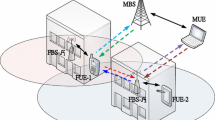Abstract
Due to the continuous evolving of mobile communication technologies, deploying small cells (SCs), also known as SC base stations (SBSs), is regarded as one of the feasible alternatives to provide better indoor signal quality to meet the ever-increasing demand for mobile broadband data in indoor environments. However, the co-tier uplink interference, i.e., interference between SBSs, increases when SBSs are densely deployed. Consequently, the sum-capacity of the small cell network (SCN) is deteriorated. To manage such interference, a co-tier uplink power control scheme which combines the Stackelberg game with two-way pricing mechanism is proposed. In this scheme, among the SBSs, one is selected as the leader and the rest are the followers. Under the premise of not violating the maximum tolerable uplink co-tier interference constraint, leader UE and follower UEs achieve the compromised uplink transmit power based on the proposed two-way bargaining procedure. The average sum-capacity of the SCN and the average uplink transmit power of leader UE and follower UEs are used as the major metrics to evaluate the performance of the proposed scheme. Compared with the simulation results obtained by only controlling the transmit power of follower UEs, i.e., Stackelberg game with one-way pricing, the proposed co-tier uplink power control scheme, i.e., Stackelberg game with two-way pricing, attains higher sum-capacity with smaller transmit power.














Similar content being viewed by others
References
Nokia, Ultra Dense Network (UDN) White Paper. (https://resources.ext.nokia.com/asset/200295 available on October 24, 2017)
Cisco, Cisco Visual Networking Index: Global Mobile Data Traffic Forecast Update, 2017–2022 White Paper. (https://www.cisco.com/c/en/us/solutions/collateral/service-provider/visual-networking-index-vni/white-paper-c11-738429.html available on April 18, 2019)
Andrews JG, Buzzi S, Choi W, Hanly SV, Lozano A, Soong ACK, Zhang JC (2014) What will 5G be? IEEE J Sel Areas Commun 32(6):1065–1082
Gotsis A, Stefanatos S, Alexiou A (June 2016) Ultra dense networks: the new wireless frontier for enabling 5G access. IEEE Trans Veh Technol Mag 11(2):71–78
Small Cell Forum, Small Cell Definition. (http://www.smallcellforum.org/about/about-small-cells/small-cell-definition/ available on July 14, 2017)
3GPP TS 36.304, “Evolved Universal Terrestrial Radio Access (E-UTRA); User Equipment (UE) Procedures in Idle Mode,” V15.3.0, March 2019
Xia P, Chandrasekhar V, Andrews JG (2010) Open vs. closed access Femtocells in the uplink. IEEE Trans Wirel Commun 9(12):3798–3809
Ge X, Cheng H, Guizani M, Han T (2014) 5G wireless backhaul networks: challenges and research advances. IEEE Netw 28(6):6–11
Coldrey M, Berg J-E, Manhaolm L, Larsson C, Hansryd J (2013) Non-line-of-sight small cell backhauling using microwave technology. IEEE Commun Mag 51(9):78–84
Jaber M, Imran MA, Tafazolli R, Tukmanov A (2016) 5G backhaul challenges and emerging research directions: a survey. IEEE Access 4:1743–1766
Jo HS, Mun C, Moon J, Yook JG (2009) Interference mitigation using uplink power control for two-tier Femtocell networks. IEEE Trans Wirel Commun 8(10):4906–4910
Tseng C-C, Wang H-C, Ting K-C, Tsai Y-F, Kuo F-C (2017) Mitigating Uplink Interference in Femto-Marco Coexisted Heterogeneous Network by Using Power Control. Wirel Pers Commun 95(1):83–100
Chen L, Xia H, Feng C, Wu S (2015). Clustering-based co-tier interference coordination in dense small cell networks, 2015 IEEE 26th Annual International Symposium on Personal, Indoor, and Mobile Radio Communications (PIMRC)
Altman E, Boulogne T, El-Azouzi R (2006) A survey on networking games in telecommunications. Comput Oper Res 33(2):286–311
Mark Felegyhazi and J.-P. Hubaux. Game theory in wireless networks: A Tutorial, EPFL Technical Report: LCA-REPORT-2006-002
Saad W, Han Z, Basar T, Debbah M, Hjorungnes A (2011) Network formation games among relay stations in next generation wireless networks. IEEE Trans Commun 59(9):2528–2542
Kang X, Zhang R, Motani M (2012) Price-based resource allocation for Spectrum-sharing Femtocell networks: a Stackelberg game approach. IEEE J Sel Areas Commun 30(3):538–549
Tseng C-C, Peng C-S, Lo S-H, Wang H-C, Kuo F-C, Ting K-C (2014). Co-tier uplink power control in femtocell networks by stackelberg game with pricing,” International Conference on Wireless Communications, Vehicular Technology, Information Theory and Aerospace @ Electronic Systems (VITEA)
von Stackelberg H (2011) Market Structure and Equilibrium: 1st edition translation into English. Springer, Bazin, Urch & Hill
3GPP TSG RAN WG4 (Radio) Meeting #51 R4–092042 (2009). “Simulation assumptions and parameters for FDD HeNB RF Requirements,” May 2009
Arvidsson P (2011). Channel estimation error model for SRS in LTE. Master Thesis, KTH
Lopez-Perez D, Ladanyi A, Juttner A, Rivano H, Zhang J (2011). Optimization method for the joint allocation of modulation schemes, coding rates, resource blocks and power in self-organizing LTE networks, IEEE INFOCOM
Acknowledgments
This paper was supported in part by the Ministry of Science and Technology of Taiwan under the grant number 105–2221-E-197-003. Preliminary results of this work were published in IoTaaS 2017.
Author information
Authors and Affiliations
Corresponding author
Additional information
Publisher’s note
Springer Nature remains neutral with regard to jurisdictional claims in published maps and institutional affiliations.
Rights and permissions
About this article
Cite this article
Tseng, CC., Wang, HC., Ting, KC. et al. Co-Tier Uplink Power Control in Small Cell Networks by Stackelberg Game with Two-Way Pricing Mechanism. Mobile Netw Appl 26, 1093–1106 (2021). https://doi.org/10.1007/s11036-020-01619-y
Published:
Issue Date:
DOI: https://doi.org/10.1007/s11036-020-01619-y




